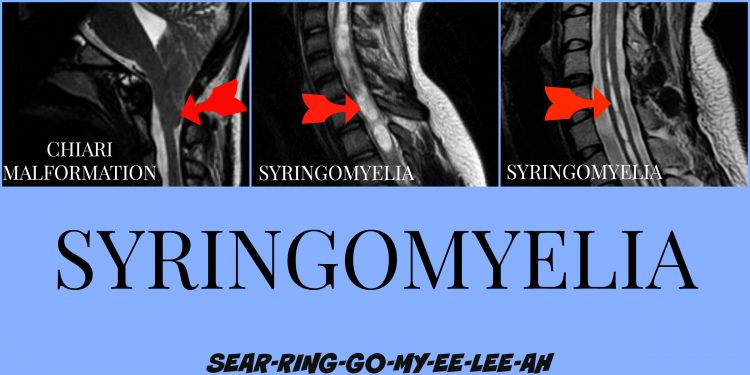Here are 15 things people with a diagnosis of syringomyelia want you to know:
1. Syringomyelia (SM) is a disease and it can be complicated.
2. Syringomyelia can cause moderate to severe pain and it has been described this way:
“I feel as if someone beat me with a baseball bat from my head down to my toes.” – SM and moderate pain-syrinxes in c-spine, t-spine, and l-spine
“I feel as if I have a vice grip around my chest and it hurts.”- SM-thoracic syrinx
“My head hurts so bad, I am nauseated all of the time, and my vision is affected at times.” – SM with Intracranial Hypertension
“My neck and shoulders hurt.”- SM and Cape pain
“I feel like my brain is being pulled out of the back of my skull…worst headache ever!”- SM and Chiari malformation I
“I have whooshing in my ears so loud it keeps me awake.” – SM and papilledema with intracranial hypertension
“I drop things all of the time and my arms are weak.” – SM and cervical syrinx
“My heart rate skyrockets whenever I move and I have trouble catching my breath without oxygen” – SM and autonomic dysfunction with severe tachycardia. The tachycardia was left untreated and the individual developed pulmonary hypertension with heart failure. Syrinxes in the c-spine, t-spine, and l-spine. SM, syringobulbia, and Tarlov cysts in the sacrum.

3. Syringomyelia can be “invisible” to those looking from the outside in… you cannot see the cysts inside the spinal cord, or damaged spinal cord or nerves. The truth is that Syringomyelia can cause multiple physical symptoms and men, women, and children may not always use a wheelchair or medical device.
4. Syringomyelia may require many doctors and specialists to treat it including primary care/pediatrics, neurosurgery, neuro-opthalmology, neurology, pain management, autonomic nervous system specialists, pulmonology, cardiology, gastroenterology, and many more!
5. Syringomyelia can have flares and remissions.
“I may be able to go to the grocery store one day and not be able to get out of bed the next day. I am ‘paying’ for the activity from the day before… it takes great sacrifice to participate in even simple activities.”
“If I shop at Walgreens I can make it to the back of the store and check out OK. If I go to Costco by the time I make it to the back of the store I cannot feel my legs. I have so much sensory damage if I am on my feet too long I lose sensation from the waist down. The feeling may return after I lie flat and rest for a few hours. I am afraid one day the feeling in my legs won’t return.”
6. The truth is that there are many patients that have syringomyelia without Chiari malformation. Both syringomyelia and Chiari malformation can cause many similar symptoms independently on their own and complications may become life threatening if ignored.
7. “Complex” may mean the treatment for one complication of syringomyelia can contradict the treatment for another.
8. “Complex” may also mean that having a cervical syrinx (syringobulbia) can affect the brainstem: the brainstem controls things we don’t have to think about like breathing, heart rate, respirations, and temperature regulation.
9. Difficult means having a thoracic syrinx and here is a clear description: “Feels like you are in a vice grip or in a medieval torture device squeezing the life out of your midsection 24/7.”
10. The truth is syrinxes large and small can cause symptoms. Even if syrinxes shrink or go away the spinal cord and spinal nerve damage caused by their presence may remain. A diagnosis of syringomyelia means care is required over the person’s lifetime: close monitoring with appropriate treatment, assessment, reassessment, and ongoing multidisciplinary care are required for the best outcome and quality of life!
11. Right now in 2017 with feedback from our community, a large number of individuals living with syringomyelia have reported difficulty locating nurses, physicians, and ancillary staff that recognize the complexity of syringomyelia worldwide. This same problem has been reported with Chiari malformation.
12. The truth is that when left untreated or without appropriate medical care syringomyelia and Chiari both could lead to life-threatening complications including brain stem compression and subsequent herniation, respiratory compromise, cardiovascular abnormalities, central and obstructive sleep apneas, and paralysis to name a few but there are more.
13. The sad truth is that men, women, and children have passed away from complications connected to both SM and Chiari. In many cases early identification of the complication could have saved a life! Ongoing medical education is critical with regard to SM and Chiari.

14. We welcome physicians, nurses, and ancillary staff that would like more information about syringomyelia and Chiari from all specialties of medicine. We always love to share across all medical disciplines and we are happy to provide resources!
15. Men, women, and children with SM and Chiari deserve excellent ongoing medical care!
Learn more about syringomyelia and Chiari today or contact our nurses for an educational session. We also have free educational advocacy tools available for free download on our website: www.wstfcure.org. You may also email us at wstfcure@wstfcure.org.

